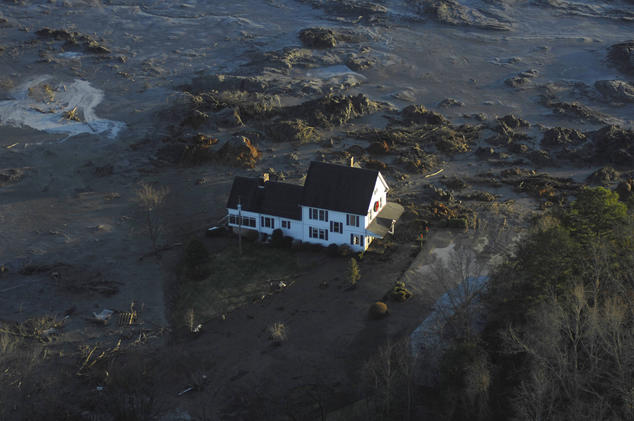By Glynn Wilson –
It’s a scene right out of an apocalyptic movie, only no one was awake to see it — and there’s no viral video footage to show. It was midnight, Dec. 21, 2008, when a failure of a dike containing coal ash on the bank of the Emory River at the Tennessee Valley Authority’s coal-fired power plant in Kingston, Tennessee, just west of Knoxville, created a tsunami wave carrying 1.1 billion gallons of toxic ash. Overnight it filled up and overflowed the Swan Pond embayment area and dumped so much material into the Emory and Clinch Rivers where they met at Kingston that it literally dammed up the rivers temporarily, both tributaries of the Tennessee River, also impacted by the geological disaster that was more than a mere spill.
The disastrous event created a mountain of toxic sludge that covered 300 acres of the surrounding land, resulted in millions of dollars in property damage and rendered many properties uninhabitable, as well as causing untold damage to the local ecosystem.
“If it had happened at any other time, there would have been a body count,” said Steve Scarborough, a somewhat reluctant expert on coal ash since the spill devastated his part of the world and devalued hundreds of acres he owns and oversees as conservator, in a recent interview. “If it had happened in the summer time, there would have been hundreds if not thousands killed.”
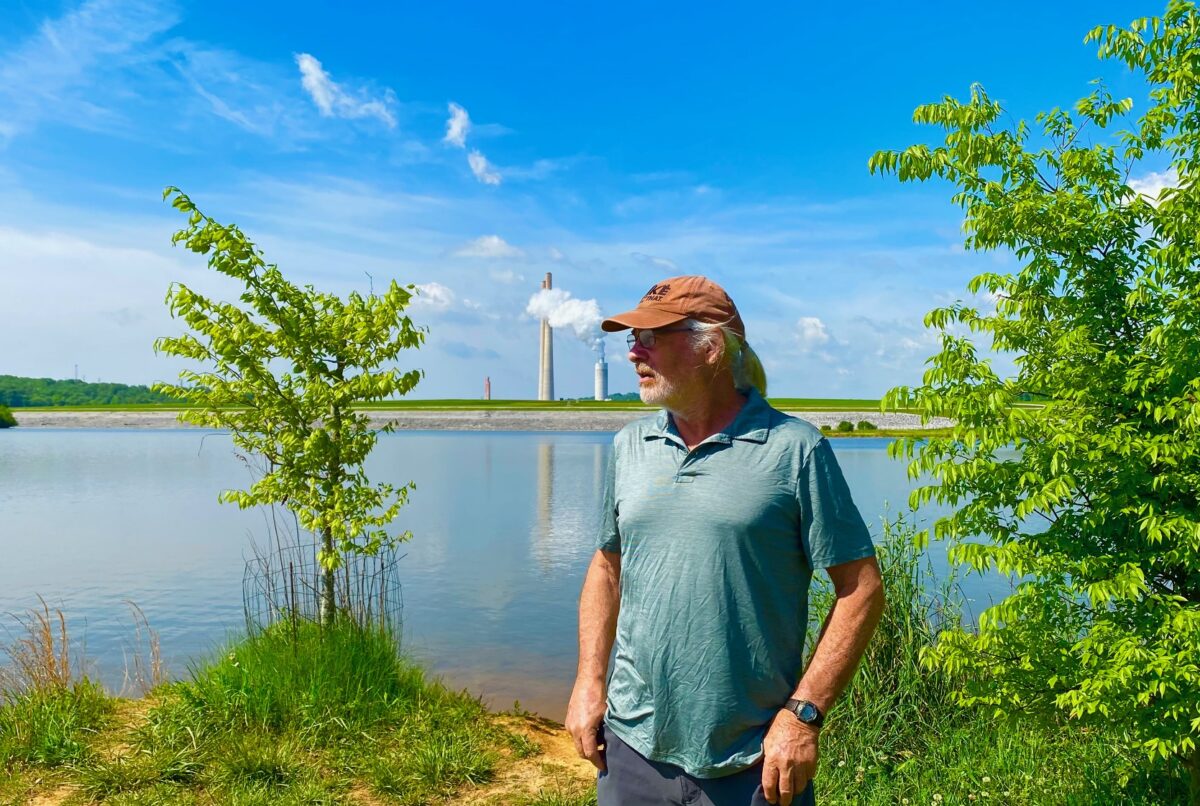
Steve Scarborough by the Emory River with TVA’s Kingston coal fired power plant in the background: Glynn Wilson
We interviewed Scarborough for the big disaster story back in 2009, and hooked up with him again to check out the scene 12 years later, with the rivers now flowing again and teeming with fish, also habitat for numerous bird species and other wildlife. He says everything was dead in the area for two years, but the environment has come back for the most part now.
At the time of the disaster, ash was piled up 80 feet above the level of the water, eight stories high, he said. When that collapsed, coal ash traveled 15 miles downstream and 8 miles upstream.
“Nobody would have told you it traveled upstream, but it did,” he said.
TVA said it didn’t, because they weren’t sampling upstream, he said, but private citizens tested it and confirmed it.
Related Coverage from 2009: TVA to Begin Coal Ash Spill Cleanup March 20 (2009)
“Of course TVA blamed it on cold weather, all kinds of stuff. They would up saying it was not ‘our’ fault because there was an undetected layer of slime that caused the problem, which,” he said, “that’s not true. They put that layer of slime there back when they were first doing this stuff.”
Burning coal for power and piling up the toxic ash by the river, that is.
“Truth has been pretty well battered in this whole thing and pretty much makes me not trust anything that TVA says about its operation. I know things they stated publicly were flat out lies. The biggest one everyone’s realizing now is, it’s not just dirt,” Scarborough said with a wry laugh. “It’s a problem.”
An ongoing investigation by a local newspaper reveals that TVA has known since at least 1981 that its coal ash contained radium 226 at levels that could cause cancer but never revealed the threat to the public, purchasers of coal ash and coal ash workers.
“TVA instead has insisted its coal ash is no more dangerous than dirt,” The Knoxville News-Sentinel reported in a series of stories.
Coal ash, a catchall term for several kinds of waste left over at power plants that burn coal, contains a number of substances harmful to human health including arsenic, chromium, lead and mercury. Exposure to it for humans is incredibly dangerous, according to science and health experts. Short-term exposure can bring irritation of the nose and throat, dizziness, nausea, vomiting, and shortness of breath. Long-term exposure can lead to liver damage, kidney damage, cardiac arrhythmia and a variety of cancers.
Every year hundreds of American coal plants generate about 110 million tons of ash. Most of it gets mixed with water and stored in sludgy basins known as coal ash ponds, which have an unfortunate tendency to leak or flood or spill, sometimes in catastrophic amounts. It is a problem in many states, notably Tennessee, Alabama, Georgia and North Carolina.
Despite the protests of many whose lives have been affected by this demonstrably toxic substance, the U.S. Environmental Protection Agency has for years refused to classify coal ash as hazardous waste. Instead, the agency continues to regard coal ash as solid waste — the same designation given to household garbage.
The distinction is an important one. As solid waste, coal ash is subject to different and far less stringent federal regulations regarding how it is handled than something officially deemed “hazardous” would be. The U.S. government didn’t exercise any authority over the handling of coal ash until 2015, when President Obama’s EPA issued the first-ever federal rule pertaining to its disposal — in direct response to the Tennessee spill. During the dealmaking process that led up to the rule, coal companies lobbied for the solid-waste designation, which they knew would ultimately give states and utilities the lion’s share of responsibility for enforcement. And they got it — in exchange for allowing the federal government to place coal ash within its (very limited) purview for the first time.
“Coal ash is a hazardous substance, no matter what the EPA and the TVA prefer to call it,” the National Resources Defense Council says. “Whether it spills in huge deluges or seeps quietly into our water supplies, it’s just one of the many dangerous by-products of our irrational attachment to a dirty fossil fuel whose time has come and gone. It’s time to invest fully in renewable energy sources — and consign coal ash to the ash bin of history, where it belongs.”
It’s not only toxic to humans, killing many of the workers who helped clean up the Kingston mess, it is full of uranium and highly radioactive, far more than admitted by TVA or the state environmental agency, according to reporting by the Knoxville News-Sentinal.
The coal ash produced at a Tennessee Valley Authority coal-fired power plant near Knoxville is more than three times richer in uranium – and the dangerous radioactive elements it produces as it breaks down – than documented in public reports after a massive coal ash spill in 2008, the paper reported in 2017 after commissioning Duke University to analyze samples of coal ash the news organization obtained from TVA’s Kingston Fossil Plant, the site of the largest coal ash spill in American history.
The Duke University analysis showed TVA’s Kingston coal ash contains more than three times the amount of uranium reported in 2009 by the Tennessee Department of Environment and Conservation and in 2011 in a joint report from TVA and its disaster cleanup contractor Jacobs Engineering. The independent tests showed an average uranium content of 15 milligrams per kilogram, ranging from 11.9 to 17.3 milligrams per kilogram.
Duke University Professor Avner Vengosh said the test results confirm the radiological threat TVA’s coal ash poses when it becomes airborne.
“If it is dust and you inhale it, it’s a different ballgame,” he explained. “Then, you have radiation in your lungs.”
As it decays, uranium produces more dangerous forms of radioactive heavy metals, including radium 226. The state agency has insisted that the state lab couldn’t detect any radium in its analysis of Kingston coal ash aside from the reading it deleted from the final public report. That reading exceeded federal pollution control standards, according to the local newspaper.
Vengosh’s research on coal ash spans more than a decade. He and his fellow researchers at Duke University were the first to raise a radiological alarm about the threat TVA’s Kingston coal ash posed if it became airborne. He is a leading figure in North Carolina’s fight to force Duke Energy to dig up its coal ash waste dumps and clean up the contamination left behind. Earlier this year, Duke Energy struck a deal with North Carolina regulators to do just that.
In Alabama, on the other hand, Alabama Power is trying to obtain state permits to bury its coal ash in place on the banks of rivers — before the Biden administration can consider classifying it as hazardous waste.
Related Coverage: A Socially Distant ‘Public’ Hearing Over Alabama Power’s Plan to Cap a Coal Ash Pond
TVA and Jacobs Engineering are being sued in both federal and state court for allegedly covering up the health threat from coal ash. Hundreds of disaster relief workers who cleaned up TVA’s Kingston spill allege they were poisoned by exposure to coal ash dust without adequate protection. An ongoing tally from public records shows 48 cleanup workers died from ailments they claim are linked to their exposure.
But one of the more sordid aspects of the Kingston workers’ case has been the degree to which TVA and the state agency responsible for the spill repeatedly referred to coal ash’s EPA classification defend itself from criticism that it knowingly put workers at risk, according to the NRDC. The TVA website makes sure to put that classification near the very top of its insubstantial page dedicated to coal ash. The page then goes on to tout what the TVA would like people to think of as the protean benefits of recovered coal ash, which can be used as an additive in the manufacture of concrete and wallboard.
“The authors even have the audacity to pitch one form of coal ash as ‘an eco-friendly alternative to salt’ for cities that have to deal with snow-covered roads,” the group says on its website. “It takes a lot of gall to characterize coal ash as an eco-friendly alternative to anything. But the coal industry and its defenders have never been accused of lacking gall.”
Last year, as part of the Trump administration’s effort to nullify the environmental record of Barack Obama and appease polluting industries, Andrew Wheeler (in his first major step as acting EPA administrator) announced that his agency would be significantly amending the 2015 coal ash rule, transferring even more monitoring power away from the federal government to the states and their local utilities.
Scarborough says the environment in the area has pretty much come back now, 13 years later.
“Mother Nature will take care of things if you quit messing her up,” he said. “For two years it was scary.”
That’s how long it took TVA to dig half the ash out of the rivers and haul it by train car to Perry County, Alabama, where they buried it in a regular county household garbage landfill in a poor minority neighborhood.
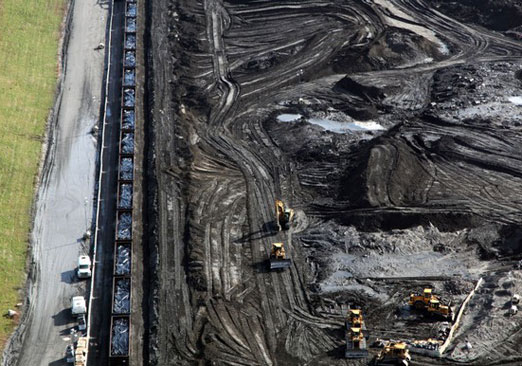
The toxic TVA coal ash mountain grows higher every day at the Arrowhead Landfill in Alabama’s Black Belt as millions of tons make their way down in train after train from one of the worst environmental disasters in U.S. history at Kingston, Tennessee: Glynn Wilson
The final cost of cleaning up the disaster to TVA and ultimately its customers has been estimated at $1.4 billion, and that’s not counting the $640 million in lost property values in the area.
“Property values went down and stayed depressed, and are just now starting to eek back up,” he said.
The fish and birds are back, he said, but the economy is not the same.
“What we don’t have is the economic boom that we had because we still have that disaster stink on us,” he said.
A report jointly published by the Environmental Integrity Project and Earthjustice found that the “vast majority” of 250 coal ash ponds had leaked their chemical brews into nearby groundwater sources. More than 90 percent of the nation’s coal-fired power plants reported elevated levels of toxic pollutants in these groundwater sources — levels that in many cases exceed the thresholds established by the EPA.
Is it about time now for the new Biden administration’s EPA staff to take up regulating coal ash as hazardous waste?
“In light of everything we now know and have seen with the sick and dying TVA disaster cleanup workers,” Scarborough said, “absolutely yes!”
Related Coverage: Toxic Coal Ash is Back on the Agenda as an Environmental Issue of Our Time

Steve Scarborough looks out at the Emory River from a riverfront lot he has been unable to sell for 13 years due to the “stink” of the spill on local property values: Glynn Wilson
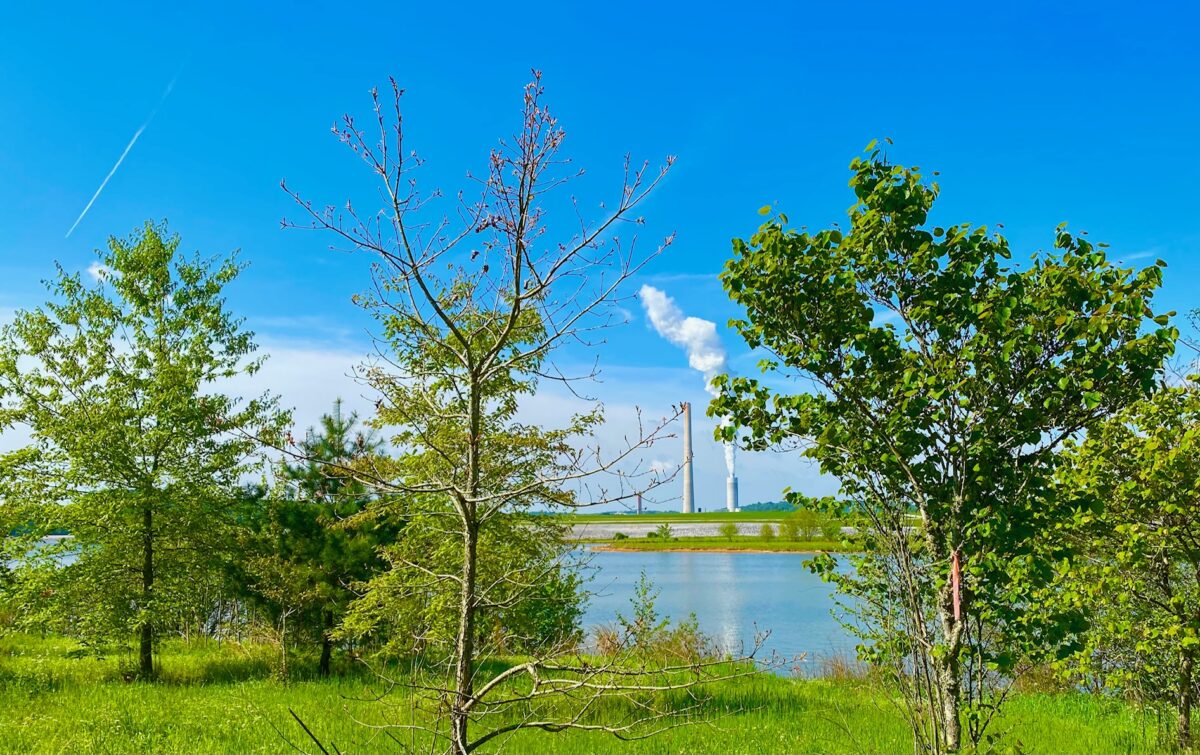
A view of TVA’s Kingston coal fired power plant in the park created on top of the disaster zone: Glynn Wilson
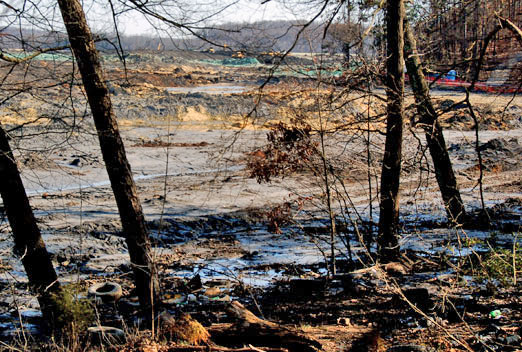
A six mile long land mass of coal ash where the most vibrant and biologically diverse stretch of the Emory River used to be: Glynn Wilson
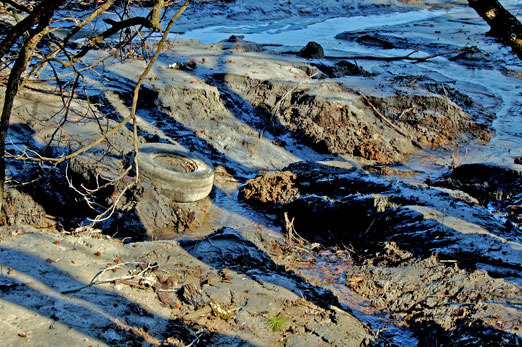
A six mile long land mass of coal ash where the most vibrant and biologically diverse stretch of the Emory River used to be: Glynn Wilson
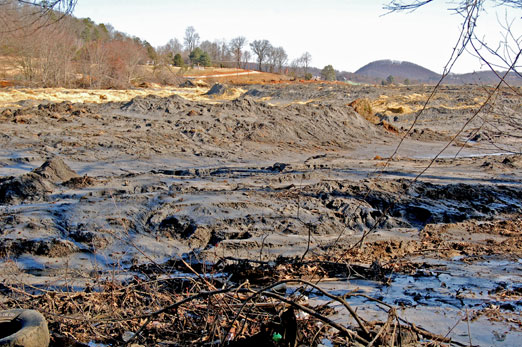
A six mile long land mass of coal ash where the most vibrant and biologically diverse stretch of the Emory River used to be: Glynn Wilson
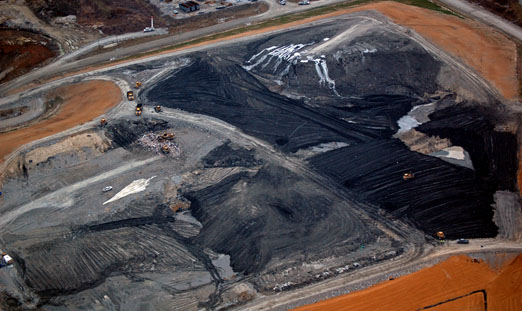
The toxic TVA coal ash mountain grows higher every day at the Arrowhead Landfill in Alabama’s Black Belt as millions of tons make their way down in train after train from one of the worst environmental disasters in U.S. history at Kingston, Tennessee: Glynn Wilson


